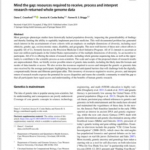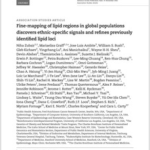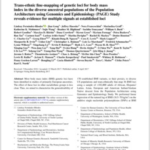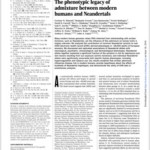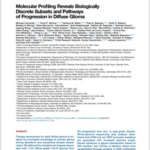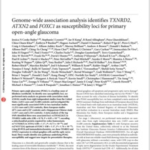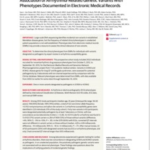Crawford DC, Cooke Bailey JN, Briggs FBS,. Most genotype-phenotype studies have historically lacked population diversity, impacting the generalizability of findings and thereby limiting the ability to equitably implement precision medicine. This well-documented problem has generated much interest in the ascertainment of new cohorts with an emphasis on multiple dimensions of diversity, including race/ethnicity, gender, age, […]
Tag Archives: Humans
Fine-mapping of lipid regions in global populations discovers ethnic-specific signals and refines previously identified lipid loci.
Genome-wide association studies have identified over 150 loci associated with lipid traits, however, no large-scale studies exist for Hispanics and other minority populations. Additionally, the genetic architecture of lipid-influencing loci remains largely unknown. We performed one of the most racially/ethnically diverse fine-mapping genetic studies of HDL-C, LDL-C, and triglycerides to-date using SNPs on the MetaboChip […]
Fine-mapping of lipid regions in global populations discovers ethnic-specific signals and refines previously identified lipid loci.
Zubair N, Graff M, Luis Ambite J, Bush WS, Kichaev G, Lu Y, Manichaikul A, Sheu WH, Absher D, Assimes TL, Bielinski SJ, Bottinger EP, Buzkova P, Chuang LM, Chung RH, Cochran B, Dumitrescu L, Gottesman O, Haessler JW, Haiman C, Heiss G, Hsiung CA, Hung YJ, Hwu CM, Juang JJ, Le Marchand L, Lee […]
Trans-ethnic fine-mapping of genetic loci for body mass index in the diverse ancestral populations of the Population Architecture using Genomics and Epidemiology (PAGE) Study reveals evidence for multiple signals at established loci.
Most body mass index (BMI) genetic loci have been identified in studies of primarily European ancestries. The effect of these loci in other racial/ethnic groups is less clear. Thus, we aimed to characterize the generalizability of 170 established BMI variants, or their proxies, to diverse US populations and trans-ethnically fine-map 36 BMI loci using a […]
Trans-ethnic fine-mapping of genetic loci for body mass index in the diverse ancestral populations of the Population Architecture using Genomics and Epidemiology (PAGE) Study reveals evidence for multiple signals at established loci.
Fernández-Rhodes L, Gong J, Haessler J, Franceschini N, Graff M, Nishimura KK, Wang Y, Highland HM, Yoneyama S, Bush WS, Goodloe R, Ritchie MD, Crawford D, Gross M, Fornage M, Buzkova P, Tao R, Isasi C, Avilés-Santa L, Daviglus M, Mackey RH, Houston D, Gu CC, Ehret G, Nguyen KH, Lewis CE, Leppert M, Irvin […]
The phenotypic legacy of admixture between modern humans and Neandertals.
Many modern human genomes retain DNA inherited from interbreeding with archaic hominins, such as Neandertals, yet the influence of this admixture on human traits is largely unknown. We analyzed the contribution of common Neandertal variants to over 1000 electronic health record (EHR)-derived phenotypes in 28,000 adults of European ancestry. We discovered and replicated associations of […]
The phenotypic legacy of admixture between modern humans and Neandertals.
Simonti CN, Vernot B, Bastarache L, Bottinger E, Carrell DS, Chisholm RL, Crosslin DR, Hebbring SJ, Jarvik GP, Kullo IJ, Li R, Pathak J, Ritchie MD, Roden DM, Verma SS, Tromp G, Prato JD, Bush WS, Akey JM, Denny JC, Capra JA,. Many modern human genomes retain DNA inherited from interbreeding with archaic hominins, such […]
Molecular Profiling Reveals Biologically Discrete Subsets and Pathways of Progression in Diffuse Glioma.
Therapy development for adult diffuse glioma is hindered by incomplete knowledge of somatic glioma driving alterations and suboptimal disease classification. We defined the complete set of genes associated with 1,122 diffuse grade II-III-IV gliomas from The Cancer Genome Atlas and used molecular profiles to improve disease classification, identify molecular correlations, and provide insights into the […]
Molecular Profiling Reveals Biologically Discrete Subsets and Pathways of Progression in Diffuse Glioma.
Ceccarelli M, Barthel FP, Malta TM, Sabedot TS, Salama SR, Murray BA, Morozova O, Newton Y, Radenbaugh A, Pagnotta SM, Anjum S, Wang J, Manyam G, Zoppoli P, Ling S, Rao AA, Grifford M, Cherniack AD, Zhang H, Poisson L, Carlotti CG, Tirapelli DP, Rao A, Mikkelsen T, Lau CC, Yung WK, Rabadan R, Huse […]
Genome-wide association analysis identifies TXNRD2, ATXN2 and FOXC1 as susceptibility loci for primary open-angle glaucoma.
Primary open-angle glaucoma (POAG) is a leading cause of blindness worldwide. To identify new susceptibility loci, we performed meta-analysis on genome-wide association study (GWAS) results from eight independent studies from the United States (3,853 cases and 33,480 controls) and investigated the most significantly associated SNPs in two Australian studies (1,252 cases and 2,592 controls), three […]
Genome-wide association analysis identifies TXNRD2, ATXN2 and FOXC1 as susceptibility loci for primary open-angle glaucoma.
Bailey JN, Loomis SJ, Kang JH, Allingham RR, Gharahkhani P, Khor CC, Burdon KP, Aschard H, Chasman DI, Igo RP, Hysi PG, Glastonbury CA, Ashley-Koch A, Brilliant M, Brown AA, Budenz DL, Buil A, Cheng CY, Choi H, Christen WG, Curhan G, De Vivo I, Fingert JH, Foster PJ, Fuchs C, Gaasterland D, Gaasterland T, […]
Association of Arrhythmia-Related Genetic Variants With Phenotypes Documented in Electronic Medical Records.
Van Driest SL, Wells QS, Stallings S, Bush WS, Gordon A, Nickerson DA, Kim JH, Crosslin DR, Jarvik GP, Carrell DS, Ralston JD, Larson EB, Bielinski SJ, Olson JE, Ye Z, Kullo IJ, Abul-Husn NS, Scott SA, Bottinger E, Almoguera B, Connolly J, Chiavacci R, Hakonarson H, Rasmussen-Torvik LJ, Pan V, Persell SD, Smith M, […]

